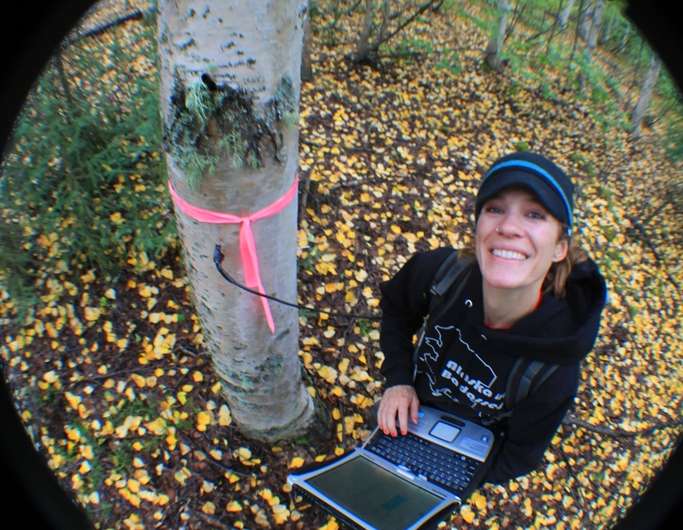Trees' surprising role in the boreal water cycle quantified

Approximately 25 to 50 percent of a living tree is made up of water, depending on the species and time of year. The water stored in trees has previously been considered just a minor part of the water cycle, but a new study by University of Alaska Fairbanks scientists shows otherwise.
Research published this week in Scientific Reports is the first to show that the uptake of snowmelt water by deciduous trees represents a large and previously overlooked aspect of the water balance in boreal watersheds. The study was led by Jessica Young-Robertson, who worked with other scientists from the National Weather Service and UAF's International Arctic Research Center and Geophysical Institute.
The results are critical for understanding boreal forest hydrology and ecology, including soil moisture, the availability of freshwater, tree health and the ways trees influence regional weather, particularly thunderstorms. All of these factors are important for understanding the frequency and severity of wildland fires.
Like a straw, trees draw water up from the soil and eventually release it into the atmosphere through leaves or needles. The scientists measured the water content in both deciduous and evergreen trees in several locations at different times of the year.
They found that deciduous trees took up a surprisingly large amount of water in the period between snowmelt and leaf-out. These trees absorbed 21 to 25 percent of the available snowmelt water—to the point of being completely saturated. For the boreal forest of Alaska and Western Canada, this equates to about 17-20 billion cubic meters of water per year. That is roughly equivalent to 8 million Olympic-sized swimming pools or 8-10 percent of the Yukon River's annual discharge.
The study also quantified transpiration—the water that trees release to the atmosphere. The researchers found that deciduous trees transpired 2 to 12 percent of the absorbed snowmelt water immediately after leaf-out. This concentrated period of transpiration has the potential to create more favorable conditions for atmospheric convection and thunderstorms, which start many of the wildfires in the sparsely populated boreal forest region.
Calculating the amount of water stored by deciduous trees is important. The area occupied by deciduous trees in the boreal forest is expected to increase 1 to 15 percent by the end of this century, and the absorption of snowmelt could also then increase.
This is the first study to show that deciduous tree water uptake of snowmelt water represents a large but overlooked aspect of the water balance in boreal watersheds. Tree water dynamics impact many processes. Quantifying tree water storage is important for understanding hydrology, tree response to drought and the related factors of tree water use, soil moisture and climate.
More information: Jessica M. Young-Robertson et al, Deciduous trees are a large and overlooked sink for snowmelt water in the boreal forest, Scientific Reports (2016). DOI: 10.1038/srep29504
Journal information: Scientific Reports
Provided by University of Alaska Fairbanks


















